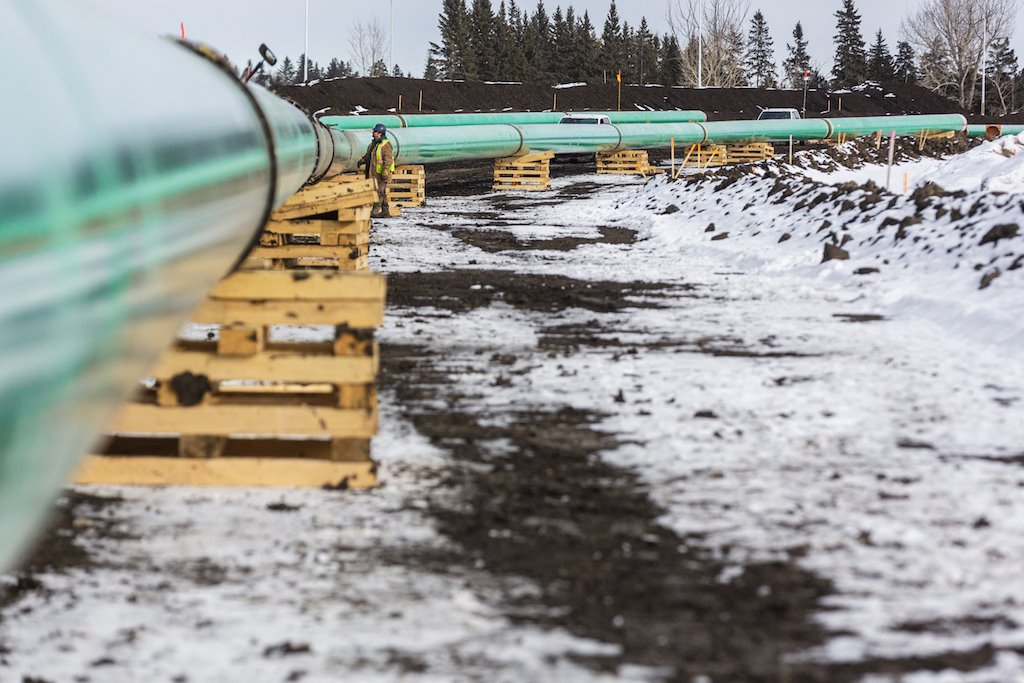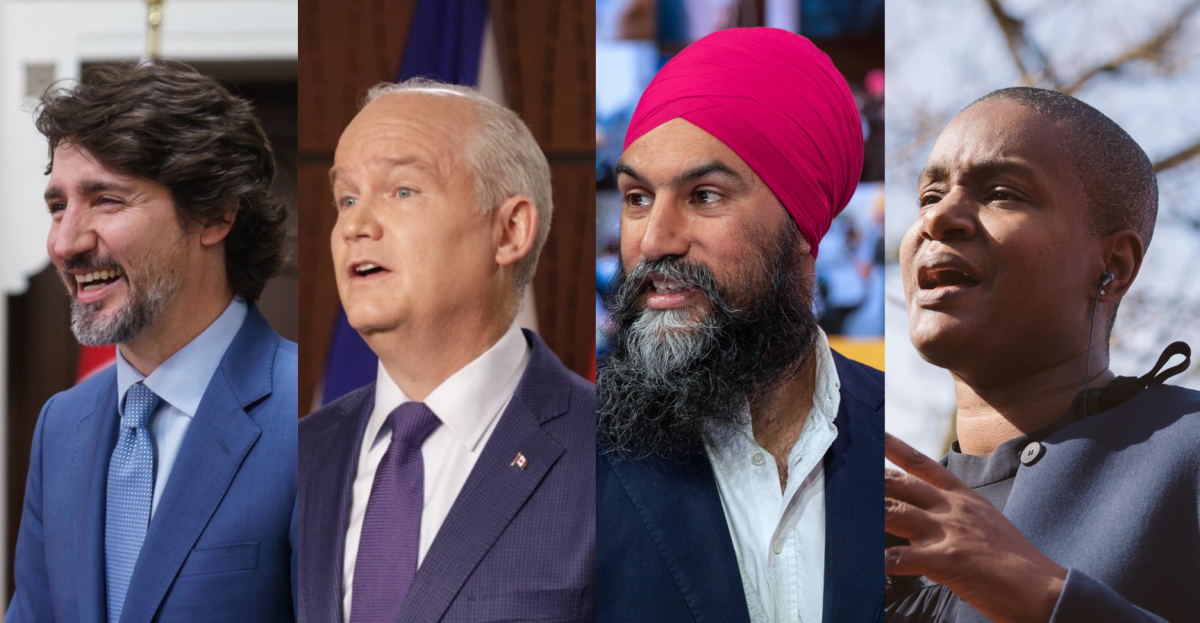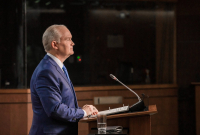Support strong Canadian climate journalism for 2025
Infused throughout the Supreme Court of Canada’s ruling that Parliament acted constitutionally when it passed the Liberal government’s carbon pricing law is the logic that the provinces are incapable of fully acting on the climate crisis themselves.
The provinces could not be relied on to set minimum standards to cut carbon pollution, even if they co-operated on a nationwide carbon pricing scheme, because they lack enforcement power, should one province fail to act, Chief Justice Richard Wagner wrote in the March 25 decision.
Not allowing Parliament to address the climate crisis at a national level would mean “irreversible consequences for the environment, for human health and safety and for the economy,” Wagner wrote.

Bugging the provinces
On Thursday, Erin O’Toole, leader of the official Opposition Conservative Party, released his long-awaited climate plan, complete with its own price on pollution, meaning that all the major national political parties now support some form of carbon pricing. (The Liberals’ plan calls for a carbon price that rises to $170 per tonne in 2030, while the Conservatives would go to $50 per tonne, “but no further,” to the dismay of some environmental groups.)
O’Toole’s plan also came with another twist: If he became prime minister, he would not insist the provinces play ball. “This is the plan I’ll be presenting to the provinces to partner with them, rather than forcing on the provinces a plan that (Prime Minister Justin Trudeau) did,” he told reporters on April 15.
The plan itself repeats this pledge: “Canada’s Conservatives will take this plan to the provinces, but, unlike the current government, we will work with them, knowing that by doing so, we’ll achieve more.”
The issue of whether the federal government should force the provinces to partner on a carbon pricing system has been debated in courtrooms across Canada for years. After all, it was legal challenges launched by the provinces of Ontario, Saskatchewan and Alberta — all of which rejected the Liberals’ plan — that led to the Supreme Court’s decision.

Acknowledging the problem
Beyond that, though, all the national parties, from the Liberals to the Conservatives, the New Democrats and the Greens, also recognize that pollution-pricing alone is insufficient to address the looming climate emergency.
To be sure, the Conservatives’ climate plan acknowledging that “Canada must not ignore the reality of climate change” is itself notable for a party that just weeks ago had some members suggesting climate change is not real. At the Conservative convention in March, a proposal that declared in part that “climate change is real” and highly polluting businesses need to “take more responsibility” was defeated, compelling O’Toole to reiterate after that he was the one “in charge” and would come out with a climate plan anyway.
Yet, just acknowledging the problem is the bare minimum. The worldwide scientific consensus is clear: Carbon pollution, created when fossil fuels like coal, oil and natural gas are burned to produce energy, has to be cut by 45 per cent by 2030 in order to avoid the more extreme effects of climate change. That means the world must begin winding down fossil fuel production today, reducing it by six per cent each year for the next decade.
That isn’t yet happening. Global pollution cuts need to increase tenfold to meet the Paris Agreement’s goals, according to a peer-reviewed scientific analysis led by Corinne Le Quéré, a scientist who chairs France’s High Council on Climate. If they don’t, places like Canada, already heating up at double the average rate of the planet, will experience more severe effects.
The Liberal government’s proposal is to achieve net-zero emissions by 2050. The government’s $15-billion climate plan is designed to achieve emissions reductions on top of those expected from its rising carbon price: it promises things like cutting energy waste through retrofit programs, boosting zero-emissions vehicles, promoting carbon capture technology, and investing in nature-based solutions. The Liberals are also rolling out a clean fuel standard and restrictions on methane.
The Conservative plan, too, goes beyond carbon pricing, requiring automakers to sell more zero-emission vehicles, increase the use of renewable natural gas, and implement a “low carbon fuel standard.”

Split on carbon-intensive projects
Both the Conservatives and the Liberals, however, have also supported the Trans Mountain oil pipeline and its associated expansion project, which would nearly triple its capacity up to 890,000 barrels per day of petroleum products flowing from Alberta to a marine terminal on Vancouver’s central harbour.
With the Liberals in power, Canada put up billions of dollars to become the pipeline’s owner and operator. The Conservatives, meanwhile, want to see more building of pipelines in Canada in general, and the Tories have previously made statements in support of not only Trans Mountain, but also of the Keystone XL pipeline, which had its permit revoked by U.S. President Joe Biden.
The fact remains that Canada is the fourth-largest oil producer and the fourth-largest natural gas producer in the world, and sits on the planet’s third-largest proven reserves of oil — 97 per cent of which is in Alberta’s oilsands — and the 17th-largest proven reserves of natural gas, spread across Alberta and British Columbia.
The NDP is against Trans Mountain. The Greens, too, are against the pipeline, and want to see the end of all oil and gas exploration projects, all new pipelines and all fracking activity.
Both of those parties have proposed a suite of solutions to the climate crisis, from the NDP’s investments in transit, energy-efficient homes and clean energy, to the Greens’ proposal to invest post-pandemic stimulus into green infrastructure and renewable energy sources.
During the NDP’s convention in April, the party's grassroots gave ironclad support to a proposal for a “green recovery,” which would have a federal New Democrat government, if elected, respond to the twin economic and climate crises with a comprehensive program to create jobs, slash carbon pollution and invest in energy-efficiency retrofits.
This Green New Deal-style package of climate change solutions and economic stimulus is popular with Canadians, and the other parties have noticed. At the Liberal national convention that same weekend, for example, attendees also endorsed a “Green New Deal” proposal, while the Green Party has proposed its own Green Recovery Climate Plan.
For one speaker at the NDP convention, the threat of climate change was paramount. “I don’t really think that fossil fuels have a place in the economy that as New Democrats we should be looking forward to,” said the speaker. “As a federal party, we need to be clear that we absolutely oppose all future carbon-intensive energy projects.”
Heavy industry like the steel and aluminum sectors that employ thousands of Canadians are carbon-intensive processes, another NDP convention speaker pointed out. These are the same types of materials that would be needed in key green recovery projects, such as public transportation or building retrofits, that person said.
“It’s not realistic to say that we cannot invest in any industries that use carbon-intensive materials,” said the speaker.

Getting the emissions reduction target right
Trudeau says he plans to use revenues from Trans Mountain to pay for his climate plans, which include Canada’s official emissions reduction target, set in 2015 as part of the Paris Agreement, for a 30 per cent emissions cut from 2005 levels by 2030.
The government says it will unveil an “enhanced” emissions target at a climate summit this month organized by the Biden administration.
Still, anything in the 30 to 40 per cent range would be “far too low,” according to Mary Robinson, the former president of Ireland and UN special envoy for climate change. Robinson said Canada needs to have a target of at least a 50 per cent cut in emissions below 2005 levels by 2030.
The NDP has said it wants “science-based greenhouse gas reductions targets” to help stabilize the global temperature rise to 1.5 C. That would translate to a reduction of about 45 per cent by 2030. The Green Party’s recovery plan calls for a 60 per cent reduction in emissions from 2005 levels by 2030.
Whatever the official target is, the unfortunate truth is that Canada’s carbon pollution has been going up, not down. Canada is the only G7 country that saw its emissions rise between 2016 and 2019, according to Le Quéré’s analysis. Recently released federal figures show that Canada's emissions were 730 million tonnes of carbon dioxide and equivalents in 2019, about one million tonnes more than the year before.

What counts as fossil fuel subsidies
The Liberals vow that 2019 will be the last year emissions rise. They say their climate plan is taking time to set in, but its effects will soon begin to show.
Yet, even as the government pursues its plan, both the NDP and the Green Party accuse the Liberals of unfairly subsidizing the oil and gas industry, making it harder for renewable energy sources and other clean technology to compete. Both parties say they would eliminate fossil fuel subsidies.
Canada originally said in 2009 that it would get rid of “inefficient” fossil fuel subsidies, as part of a commitment made at the G20. The government claims that it will do this by 2025, and launched a joint review with Argentina on the issue in 2018. That review remains unfinished.
Federal government aid continues to flow to the oil and gas sector, with Canada spending $1.9 billion in direct aid last year, according to the International Institute for Sustainable Development. Much of that funding, however, was related to shoring up jobs amid the pandemic and helping decommission abandoned oil wells.
That reason is why the Liberals say funding that goes towards environmental initiatives should not count as fossil fuel subsidies.
During his leadership campaign, O’Toole originally called fossil fuel subsidies a form of “corporate welfare,” saying he would end them, too. But he later changed his mind, yanking that promise from his platform.
Carl Meyer / Canada’s National Observer






Comments
There is no path to net-zero emissions that includes fossil fuel expansion.
Automatic fail for the Liberals and Conservatives. "Climate" plans based on – and in Trudeau's dreams – funded by fossil fuel expansion are a non-starter.
Canada's political elites, the oil industry, the Big Banks, and Corporate Canada are all banking on business-as-usual emissions scenarios where the world is still burning 100+ million barrels per day decades hence. The only scenario in which oilsands expansion makes sense.
The Trudeau govt has no intention of meeting climate targets in 2030, 2050, or ever. Trudeau climate plan is a charade.
Trudeau et al. are following Big Oil's playbook: delay, delay, delay. Increase fossil fuel production. Expand markets. Ramp up fossil-fuel subsidies. Funnel public money to fossil fuel companies. Extract as much revenue from sunk costs as possible. Grossly under-report oil & gas emissions. Use creative accounting to wipe emissions from the balance sheet. Set aspirational net-zero targets decades out into the future (2050) with no plan to meet them. No plausible roadmap to emissions targets. No numbers.
Hinge climate policies on costly, unproven at scale, commercially unviable, or non-existent technologies still on the drawing board: carbon removal from atmosphere, Small Modular Reactors, carbon capture, etc.
Pay lip service to the science, but ignore its implications.
Stall, stall, stall.
A plan to fail.
"Much of that funding, however, was related to shoring up jobs amid the pandemic and helping decommission abandoned oil wells. That reason is why the Liberals say funding that goes towards environmental initiatives should not count as fossil fuel subsidies."
Cleanup and reclamation are the costs of doing business. Relieving fossil fuel companies of those costs goes straight to their bottom line.
Ensuring that public resource wealth padded by public tax dollars continues to flow into the hands of mostly foreign shareholders.
What used to be called the polluter-pay principle is now merely an option.
Privatizing the profits, socializing the costs. The fossil fuel industry's business model.
Too bad our golden goose failed to save for a rainy day. Now with the inevitable decline of the industry, more O&G companies refuse to pay property taxes. The end game was always to dump cleanup costs on taxpayers. Ethical oil.
Canada's O&G industry has been digging into taxpayers' pockets for reclamation and cleanup costs for over a decade.
AB's O&G industry has barely started to fund its clean-up liabilities: north of $260 billion. The industry is turning to taxpayers for bailouts while milking govts for subsidies.
Thanks to AB's "responsible" oil & gas industry, AB has far more orphan wells than oil-producing states with strict timelines and upfront bonds. A responsible industry would set aside clean-up funds for a rainy day.
The reason Alberta don't have these regulations in place is because AB's oil & gas industry doesn’t want them. The industry has resisted such regulations for decades. And in AB what the industry says goes. The captured regulator does the industry's bidding.
The AB Govt, the energy regulator, and industry have had years to get their act together. The Liberal Govt is now rewarding them for their intransigence.
AB's oil & gas industry has barely started to fund its clean-up liabilities: north of $260 billion.
The industry is turning to taxpayers for bailouts while endlessly milking govts for subsidies.
In 2018, it was reported that the liability of abandoned energy infrastructure in AB is at least $260 billion -- far higher than the figure previously quoted ($58.7 billion) by govt and industry officials.
The AB Govt has only collected $1.6 billion in liability security.
The $260-billion unfunded liability is over 160x larger than the funds set aside by in the industry for clean-up. The province holds a mere 0.6% of the $260 billion in cleanup costs as security deposits.
"Cleaning up Alberta's oilpatch could cost $260 billion, internal documents warn" (Global News, 2018)
An excellent analysis, but with one GLARING OMISSION. There is not one single word about Le Bloc Québécois. BQ presently has 32 sitting MPs. That is MORE THAN THE COMBINED TOTAL of the NDP (24 MPs) and the Green party (3 MPs) . Furthermore, in Québec, political commentators know that BQ will be « competitive » with the other 4 parties during the upcoming federal elections.
Parallel to this political situation, in Québec, there is also a strong citizens' mouvement (which avoids partisan politics!!!) against hydrocarbons and climate change. It is a confederation of 130 local committees under the umbrella of RVHQ(regroupement vigilance hydrocarbures du Québec). Eleven years of climate activism should have an influence on the politics of the FIVE political parties in this province. After all, RVHQ has stopped the hydraulic fracturing in the St Lawrence lowlands, the exploitation of gas on Anticosti Island, blocked Energy East pipeline and put the brakes on Gazoduc/GNL project to export LNG from the Saguenay River. Please, check the RVHQ's site « www.rvhq.ca ». On that site, there are even a few articles in English.
In a detailed analysis, ignoring some basic facts can lead to some surprises for the ROC (Rest of Canada). National Observer writes excellent articles; this one is flawed because it deliberately ignores a strong political political party plus a strong environmental mouvement. This combination is bound to have an influence on results of the next parliament. Remember the elections of 1993! When the results were tallied, BQ had 54 MPs(out of 75 in Québec) and formed the official opposition in the federal parliament.
M. Montpetit, partly correct. The BLOC considers itself a 'nationalist party', not a national party. Yes, Quebec does have a cross-party consensus on taking climate change seriously, as does B.C., and has a relatively vigorous support program for its residents changing over to greener modes, as does B.C. , and both provinces will soon be joined by NFLD, which shares that one outstanding virtue born out of a resource, hydroelectric power in abundance.
Pre-election consensus, yes. But it's still far more important to consider what they've done, than what they said they'd do in order to get elected.
The question asked in the headline is unanswered in the article. To give readers an idea of how the various parties' platforms "stack up," the author would have to do more than simply list a few free-floating factoids about each party. What percentage of what needs to be done will be accomplished by each party's platform, including that of the Bloc Quebecois? That is the question our children's future depends on. And from my rough calculations, I believe none of the parties' platforms will--even if they should, uncharacteristically, be implement as promised--give any children comfort about their future. Telling bombastic, inadequate lies with a flourish is a mutated variant of denialism.